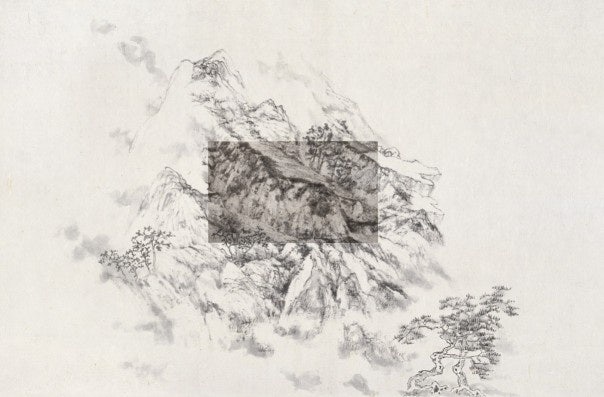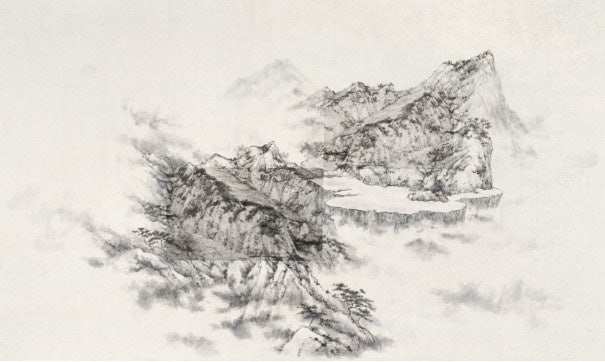Painter Arnold Chang And Photographer Michael Cherney Discuss Artistic Process, Recent Collaborations At Sold-Out Event#

Last night, at the China Institute in New York, Jing Daily attended the first of two Art Salons for the fall season, focusing on the work of two American contemporary artists working in uniquely Chinese styles: painter Arnold Chang and photographer Michael Cherney. Introduced by China Institute President Sara Judge McCalpin to the sell-out crowd, Chang and Cherney discussed their artistic backgrounds and processes, turning then to the topic of their recent collaborations, which blend aspects of traditional Chinese ink painting with photography and speak to a broader theme in today's art world of what Chang referred to as "artistic globalization."
Speaking first, Arnold Chang discussed his early artistic education, which began -- coincidentally enough -- in the area near the China Institute, where he studied under the influential artist and collector C.C. Wang. Spending two days a week studying artistic theory and technique at Wang's studio and one day a week at Wang's classes at the China Institute in the late 1970s, Chang was able to obtain something akin to the classical artistic training traditionally taught in China. Following years of study under the tutelage of Wang, copying the works of old Chinese masters, Chang said he finally had a "breakthrough" with brush and ink, fusing together the austerity of traditional Chinese painting techniques with the spontaneity of automatic painting. Inspired by the work of Wang and other modern Chinese painters like "splash ink" pioneer Zhang Daqian and "grid" painter Wucius Wong,
Chang, working in his New Jersey studio, has become one of the world's most respected painters working in the traditional Chinese style. Chang described his works as abstract and improvisational in nature, saying he simply lets his hand and wrist react to the paper semi-randomly, then connects the resultant "squiggles" according to his understanding of traditional Chinese painting to form a landscape.

Photographer Michael Cherney spoke next, discussing his upbringing in upstate New York and his ongoing photographic series on the Yangtze River (长江). Cherney's photography, which involves painstakingly cropping the landscape photographs he takes throughout the Chinese countryside, calls back to the work of ancient Chinese masters, often to the point that Cherney traces the exact geographic sources of paintings of the Song, Yuan and Qing Dynasties and reimagines them in the photographic medium. Cherney discussed his method for choosing locations to photograph, which involves significant online and museum research, as well as the use of Google Earth. Cherney discussed the preoccupation with history in his work, saying one feels surrounded and overwhelmed by history in China, and that -- despite recent efforts to the contrary -- it's hard to destroy it all.
Cherney and Chang then spoke about how they came to be friends and, later, collaborators. Cherney said he first met Chang in 2007 at the Chengdu biennial, where the two were among the roughly 70 artists from China and abroad included in the event. Chang noted some similarities and a "common essence" in their work, and the two began experimenting with ways to combine Cherney's photography -- printed on traditional xuan paper -- with Chang's ink painting as a way to "bring both media forward" into the 21st century. Cherney and Chang first showed their collaborative works at Princeton in 2009, with observers noting similarities with the work of Yuan Dynasty painter Huang Gongwang (黄公望).
Discussing with the audience their collaborative method, Cherney said he first crops and digitally alters his film images then prints them in pigment on xuan paper before shipping them from his studio in Beijing to Chang, essentially "challenging" Chang to fill in the image. Chang, speaking on the process, said he views it as "a game, a sport, a challenge," as he only gets one chance with each print.
Despite these pressures, Chang said, his collaboration with Cherney has been "so far, so good."
Images of works created by Cherney and Chang:


The Jing Daily team would like to thank Dr. Agnes Hsu, Sara Judge McCalpin, Arnold Chang and Michael Cherney for organizing this fascinating event. Don't miss the China Institute's next Art Salon event on December 16, where curator Hao Sheng will discuss his upcoming exhibition at Boston's Museum of Fine Arts, "Fine Arts, Fresh Ink: Ten Takes on Chinese Tradition." Information about this event is available on the China Institute website.